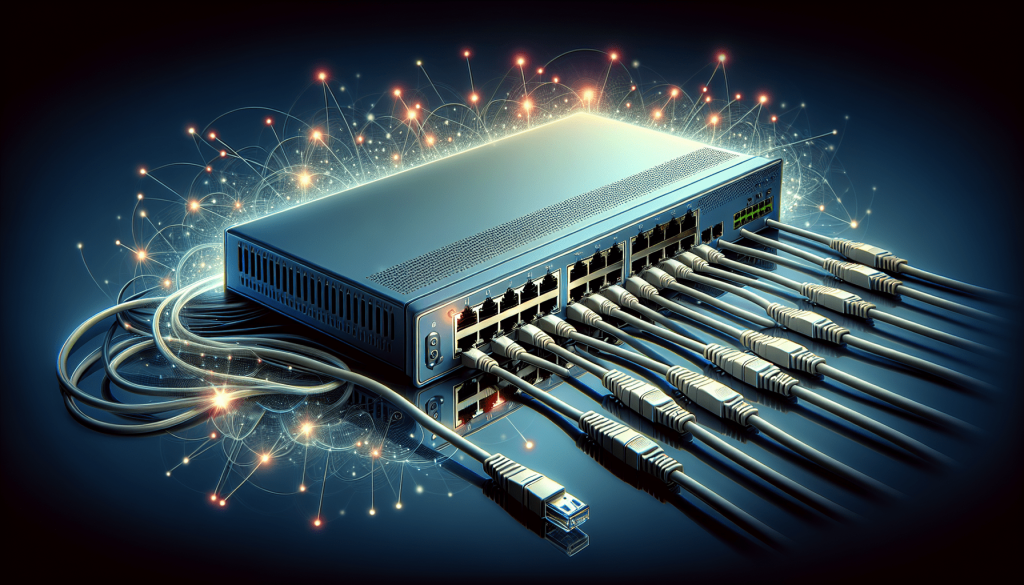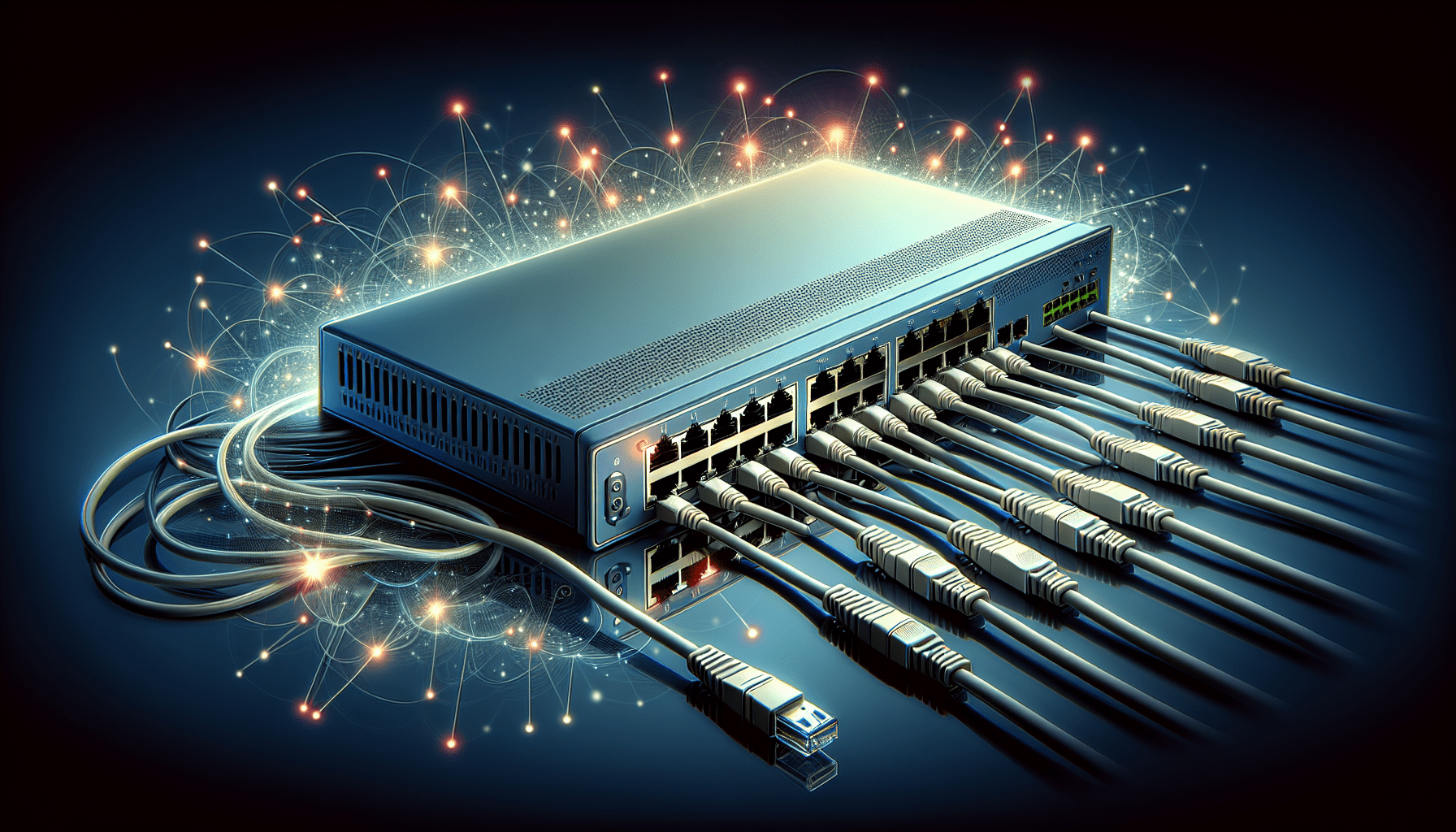So you’ve decided to embark on the exciting journey of setting up a network switch, but you’re not quite sure where to begin. Don’t worry, you’re in the right place. In this ultimate beginner’s guide, we’ll walk you through everything you need to know to get your network switch up and running smoothly. From understanding the basics to configuring your switch, we’ve got you covered. So grab a cup of tea and get ready to become a networking expert in no time!
What is a Network Switch?
Definition of a network switch
A network switch is a device that acts as a central hub for connecting multiple devices on a local area network (LAN). It operates at the data link layer of the OSI model and enables the transfer of data between devices within the network. Unlike a hub, which simply broadcasts data to all connected devices, a network switch intelligently directs traffic to the intended destination, improving network efficiency and security.
How a network switch works
A network switch works by receiving data packets from connected devices and forwarding them to the appropriate destination. It uses MAC addresses to determine the destination device and sends the packets only to that device, eliminating unnecessary traffic on the network. This process is known as “switching,” and it happens at wire speed, ensuring fast and efficient data transfer between devices.
Why use a network switch
Using a network switch offers several advantages. Firstly, it provides improved network performance and bandwidth utilization by reducing collisions and congestion. By facilitating direct communication between devices, it helps to optimize data flow and minimize network latency. Network switches also enhance network security by isolating traffic between devices and preventing unauthorized access. Additionally, they offer scalability and flexibility, allowing for easy expansion of the network as the business grows.
Types of Network Switches
Unmanaged network switches
Unmanaged network switches are the simplest type of switches and typically used in small networks or home environments. They operate on a plug-and-play basis, requiring no configuration or management. Unmanaged switches provide basic port connectivity and simply forward data packets to the destination device without any advanced features or control.
Managed network switches
Managed network switches, on the other hand, offer more advanced functionality and control over the network. They provide features such as VLAN support, Quality of Service (QoS) settings, and port mirroring. Managed switches allow network administrators to monitor and manage network traffic, configure security settings, and optimize network performance. These switches are commonly used in large-scale networks where customization and control are essential.
Layer 2 network switches
Layer 2 network switches operate at the data link layer of the OSI model. They use MAC addresses to direct traffic and make forwarding decisions. Layer 2 switches are primarily used for local network communication, offering high-speed connectivity between devices within the same subnet. They are ideal for small to medium-sized networks that do not require routing between different networks.
Layer 3 network switches
Layer 3 network switches, also known as multilayer switches, combine the features of a traditional switch with the functionality of a router. They operate at both the data link layer and the network layer of the OSI model, allowing for routing between different IP subnets. Layer 3 switches can handle more complex networks and provide better performance and scalability compared to Layer 2 switches.
PoE (Power over Ethernet) switches
Power over Ethernet (PoE) switches are a special type of network switch that can provide power to connected devices, such as IP phones, wireless access points, and IP cameras, through the Ethernet cables. This eliminates the need for separate power sources for these devices, simplifies installation, and improves flexibility. PoE switches are particularly useful in environments where power outlets are limited or difficult to access.

Choosing the Right Network Switch
Assessing your network needs
Before choosing a network switch, it is crucial to assess your network needs and requirements. Consider factors such as the number of devices that need to be connected, the type of network traffic, and the network’s growth potential. Understanding your network requirements will help you determine the appropriate switch features and specifications.
Number of ports
The number of ports needed on a network switch depends on the number of devices that require connectivity. Take into account existing devices as well as potential future additions. It is advisable to choose a switch with extra ports to allow for future expansion and flexibility.
Speed and bandwidth requirements
Consider the speed and bandwidth requirements of your network. Different switches offer different maximum speeds, typically measured in megabits per second (Mbps) or gigabits per second (Gbps). Higher speeds and bandwidth are necessary for networks that handle large amounts of data or require high-speed connectivity.
Managed vs. unmanaged switches
Decide whether a managed or unmanaged switch is more suitable for your network. Unmanaged switches are simpler and cost-effective, but lack advanced features and control. Managed switches provide greater flexibility, control, and customization options but are generally more expensive.
Considerations for future growth
Plan for future growth and scalability when selecting a network switch. Look for switches that offer features like modular expansion, stacking capabilities, and support for additional advanced features. This will allow your network to easily accommodate future expansion without requiring a complete switch replacement.
Setting Up a Network Switch
Planning the installation
Before setting up a network switch, it is essential to plan the installation process. Determine the ideal location for the switch, considering factors such as accessibility, ventilation, and cable management. Plan the placement of devices in proximity to the switch, ensuring that the cable lengths are sufficient for each connection.
Gathering necessary equipment
Ensure you have all the necessary equipment for setting up the network switch. This includes the switch itself, power cables, Ethernet cables, and any additional accessories required for the installation. It is also recommended to have cable management tools, such as cable ties and racks, to keep the cables organized and neat.
Identifying primary and uplink ports
Identify the primary port on the switch, which will be used to connect to the network router or modem. This port is usually labeled as the uplink port or marked in a distinct color. Additionally, identify any uplink ports or designated ports that will connect to other switches or network devices.
Connecting devices to the switch
Connect the network devices, such as computers, printers, and servers, to the switch using Ethernet cables. Ensure that each device is connected to an available port on the switch, and make sure the cables are securely plugged in. For devices that require power over Ethernet, make sure to connect them to the appropriate PoE-enabled ports.
Powering on the switch
Finally, power on the network switch by connecting it to a power source. Ensure that the switch receives power and that the power indicator lights up. Once powered on, the switch will initialize and start forwarding network traffic between the connected devices.

Configuring a Network Switch
Accessing the switch’s configuration interface
To configure a managed network switch, you need to access its configuration interface. This is typically done through a web browser or a command line interface (CLI) using a computer connected to the same network as the switch. Consult the switch’s user manual for specific instructions on accessing the configuration interface.
Assigning an IP address
Once you have accessed the configuration interface, assign an IP address to the switch. This allows you to manage and access the switch remotely. Configure the IP address according to your network’s IP scheme and ensure it does not conflict with other devices on the network.
Setting up VLANs (Virtual LANs)
If your network requires segmentation and isolation of traffic, configure virtual LANs (VLANs) on the switch. VLANs allow you to create distinct networks within a physical network, enabling better network management, security, and performance. Assign different ports to specific VLANs based on your network requirements.
Enabling Spanning Tree Protocol (STP)
To prevent network loops and ensure redundancy, enable Spanning Tree Protocol (STP) on the switch. STP automatically detects and prevents loops by blocking redundant paths and initiating failover mechanisms. This helps maintain network stability and prevents disruptions caused by network loops.
Configuring port security
Configure port security settings to enhance network security. This includes features such as MAC address filtering, limiting the number of MAC addresses per port, and enabling port authentication. These measures help prevent unauthorized access to the network and protect against MAC address spoofing.
Implementing Quality of Service (QoS)
Implement Quality of Service (QoS) settings on the switch to prioritize network traffic based on specific requirements. QoS ensures that critical data, such as voice or video streaming, receives priority over less time-sensitive traffic. Configure QoS parameters, such as bandwidth limits, traffic classification, and prioritization rules, to optimize network performance.
Testing and Troubleshooting
Verifying physical connections
After setting up the network switch, it is crucial to verify the physical connections. Check that all devices are properly connected to the switch and make sure the cables are securely plugged in. Ensure that there are no damaged cables or loose connections that could cause network issues.
Checking link status and activity
Check the link status and activity of each port on the switch. This can be done through the switch’s configuration interface or via LED indicators on the switch itself. Verify that each connected device has a stable link and is actively transmitting or receiving data.
Testing network connectivity
Test network connectivity by pinging devices on the network from a connected computer. Verify that packets can successfully reach their destination and that there are no significant delays or packet loss. Troubleshoot any connectivity issues by checking IP configurations, subnet masks, and gateway settings.
Resolving common network switch issues
Common network switch issues can include slow network speeds, intermittent connectivity, or devices unable to communicate. Troubleshoot these issues by checking switch configurations, verifying cable integrity, and updating firmware to the latest version. Additionally, ensure that the switch’s VLAN settings and security configurations are correct.
Troubleshooting VLAN and port-related problems
If you encounter VLAN or port-related problems, start by checking the VLAN configurations on the switch. Ensure that ports are assigned to the correct VLANs and that devices are in the appropriate VLAN. Verify that the VLAN trunking settings are correct and that the correct VLAN tags are applied to traffic.
Updating firmware and software
Regularly check for firmware and software updates for your network switch. These updates often include bug fixes, security patches, and performance improvements. Update the switch’s firmware and configuration to the latest version provided by the manufacturer to ensure optimal functionality and security.
Network Switch Best Practices
Proper cable management
Maintain proper cable management to prevent cable clutter and ensure efficient airflow around the switch. Use cable ties, cable management racks, and labeled cables to organize and identify connections easily. This not only improves aesthetics but also simplifies troubleshooting and maintenance.
Regular backups of switch configurations
Regularly back up your switch configurations to prevent data loss and facilitate easy recovery in case of any failures or disasters. Save a copy of the switch’s configuration files to a secure location or consider using a dedicated network configuration management tool.
Documentation and labeling
Document your network switch setup and label all ports and cables for easy identification. Keep a detailed record of switch configurations, VLAN assignments, and any other relevant network information. This documentation will be valuable for troubleshooting, future maintenance, and network expansion.
Securing the network switch
Implement robust security measures to protect the network switch and the overall network. Change default passwords, enforce strong access controls, and disable unnecessary services and ports. Regularly review and update security policies to mitigate potential risks and vulnerabilities.
Monitoring and logging network switch activity
Implement network monitoring and logging tools to keep track of network switch activity. Monitor network traffic, resource utilization, and performance metrics to identify any bottlenecks or anomalies. Log switch events and errors to help diagnose and resolve any network issues efficiently.
Advanced Network Switch Concepts
Stacking multiple switches
In larger networks, multiple switches can be stacked together to create a single logical switch. Stacking simplifies management and enables seamless communication between the switches. It eliminates the need for complex configurations and improves network performance and scalability.
Link aggregation (LAG) and load balancing
Link aggregation, also known as link aggregation groups (LAGs) or port channels, allows multiple physical links to be bundled together to form a single logical link. This increases link capacity and provides redundancy for critical network connections. Load balancing distributes traffic across these aggregated links, further optimizing network performance.
Virtual LAN (VLAN) trunking
VLAN trunking allows multiple VLANs to be carried over a single link between switches or routers. This enables the transport of VLANs across different network segments. VLAN trunking helps create a flexible and scalable network infrastructure by allowing VLANs to span multiple switches.
Inter-VLAN routing
Inter-VLAN routing is the process of routing traffic between different VLANs. This enables communication between devices in different VLANs while maintaining network segmentation and security. Inter-VLAN routing is typically performed by layer 3 switches or routers.
QoS prioritization
Quality of Service (QoS) prioritization allows network administrators to assign priority to specific types of traffic. This ensures that critical applications, such as voice or video streaming, receive higher priority over other less time-sensitive traffic. QoS prioritization helps optimize network performance and prevents congestion.
Redundancy and high availability
Redundancy and high availability are crucial for maintaining network uptime and preventing single points of failure. Implement technologies such as Spanning Tree Protocol (STP), Rapid Spanning Tree Protocol (RSTP), or link aggregation to create redundant paths and ensure network resilience. Redundancy and high availability help minimize network downtime and improve reliability.
Network Switch Security
Changing default passwords
One of the most critical security measures is changing the default passwords on the network switch. Many switches come with default login credentials that are publicly available, making them vulnerable to unauthorized access. Immediately change the default password to a strong and unique one to protect your switch from potential security breaches.
Enforcing strong access controls
Implement strong access controls to prevent unauthorized access to the switch. This includes using complex passwords, enabling two-factor authentication, and implementing role-based access controls (RBAC). Restrict access to the switch’s configuration interface and limit administrative privileges to authorized personnel only.
Implementing VLAN segmentation
VLAN segmentation helps improve network security by isolating network traffic and preventing unauthorized access to sensitive data. Place devices with different security requirements or data sensitivity in separate VLANs. Configure appropriate VLAN access rules and enforce strict VLAN segmentation policies to mitigate potential security risks.
Monitoring for abnormal activity
Regularly monitor network switch activity for any abnormal behavior or suspicious activity. Implement intrusion detection systems (IDS) or security information and event management (SIEM) tools to detect and alert on potential security incidents. Monitor network traffic patterns, log files, and port activity to identify any unauthorized access attempts or unusual traffic patterns.
Updating firmware and security patches
Keep your network switch firmware and security patches up to date. Manufacturers regularly release updates to address software vulnerabilities and improve overall switch performance and security. Subscribe to firmware notifications and routinely check for updates. Apply patches and updates promptly to ensure that your switch is protected against known security risks.
Network Switch Troubleshooting Tips
Checking physical connections
When troubleshooting network switch issues, start by verifying the physical connections. Ensure that all cables are securely plugged in and that there are no loose or damaged connectors. Check the switch ports and network device connections to rule out any connectivity problems caused by physical issues.
Resetting the switch to factory defaults
If you encounter persistent issues with the network switch, consider resetting it to factory defaults. This effectively clears any misconfigured settings or conflicts that may be causing the problem. However, be cautious when performing a factory reset, as it will erase all configurations and settings.
Examining switch logs
Switch logs provide valuable information for troubleshooting network issues. Examine the switch logs to identify any error messages, warnings, or abnormal activities. Log entries can help narrow down the root cause of the problem and provide insights into potential solutions.
Isolating network issues
When troubleshooting network switch issues, it is essential to isolate the problem to determine if it is specific to the switch or a broader network issue. Test connectivity with different devices and observe if the issue persists. By systematically eliminating potential factors, you can pinpoint the source of the problem more effectively.
Seeking support from vendors or network professionals
If you are unable to resolve network switch issues on your own, do not hesitate to seek support from the switch manufacturer or network professionals. They have the expertise and experience to diagnose and troubleshoot complex network problems. Reach out to vendor support or engage a network consultant to assist in resolving the issues efficiently.
Setting up and configuring a network switch can seem daunting, especially for beginners. However, by understanding the different types of switches, considering your network requirements, and following best practices, you can establish a reliable and secure network infrastructure. Regular monitoring, troubleshooting, and implementing appropriate security measures will ensure your network runs smoothly and efficiently, providing seamless connectivity for all your devices.
